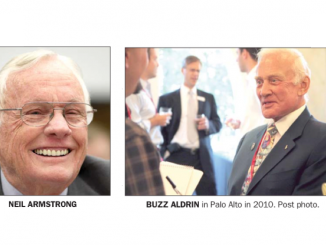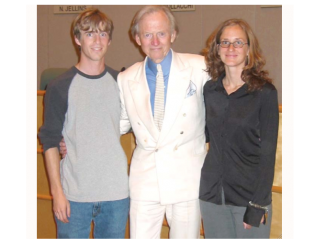
BY JAMIE MORROW
Daily Post Associate Editor
In May 1961, President John F. Kennedy famously challenged America to send a man to the moon by the end of the decade.
As he did he acknowledged that the endeavor would be so immense that, “in a very real sense, it will not be one man going to the moon — if we make this judgment affirmatively, it will be an entire nation. For all of us must work to put him there.”
At its peak, the Apollo program employed approximately 400,000 Americans and required the support of more than 20,000 industrial firms and universities, according to NASA. The cost of the program, from 1961 to 1973, was $25.4 billion, an astronomical sum at the time. Answering Kennedy’s call required tremendous manpower, resources and, most importantly, a sustained burst of technological creativity and innovation.
And key features of that came from right here, the area that was just becoming Silicon Valley in fact if not yet in name.
President Kennedy had charged NASA with landing a man on the moon – and returning him safely.
Scientists at NASA Ames Research Center at Moffett Field contributed major research that made safe re-entry possible: science that led to the design for the shape of the Apollo spacecraft and for the protective material to help it resist the searing heat of re-entry.
In the early 1950s, NASA Ames scientists were thinking about ballistic missiles, and how best to get them to re-enter our atmosphere. At the time, many scientists thought long pointy cone shapes would generate less friction, and therefore less heat.
But Ames scientist (and Stanford University alum) H. “Harvey” Julian Allen revolutionized the field with his so-called “blunt-body” theory. Pointy cones tended to concentrate heat at the tip and fall apart. Allen’s idea was that, with a blunt-shaped re-entry vehicle, atmospheric air would still heat up, but the air cushion created by the shape would push heat outward from the vehicle. It would also slow down the vehicle.
Allen, who would also serve as the center’s director from 1965 to 1969, presided over research and tests in the center’s wind tunnels to develop the theory.
The concept was also refined by Ames scientists Alfred J. Eggers, a World War II Navy lieutenant with a doctorate in engineering from Stanford, and Dean R. Chapman (who is also known for his work concerning the origin of tektites, aerodynamically shaped glassy objects found scattered over the earth’s surface).
They shaped the space capsule
Test runs led Ames researchers to conclude that the best shape for a space capsule was the iconic truncated cone with a nearly flat front face. Based on that research, NASA used the shape for the Mercury, Gemini and Apollo capsules.
The work on the shape also led to the development of the ablative heat shields that protected the Apollo capsules during re-entry. Ablation means that bits of the heat shield material, when superheated during re-entry, would burn off. And as the material burnt off, it would take heat energy with it into the atmosphere and away from the spacecraft.
Ablating materials were developed using the results of studies led by Morris W. Rubesin, Constantine Pappas, John Howe, and other researchers at Ames in the late 1950s.
Ames tested the research with arc jets, a type of wind tunnel that uses very hot gas flows to simulate re-entry in both temperature and chemistry. Aerospace firms then designed ablative heat shields for the Apollo capsules, and those were tested in the Ames arc jets by John Lundell, Roy Wakefield, Nick Vojvodich and others.
Their research was critical to the design of the Apollo thermal protection system.
In December 1963, Gerhard Hahne of Sunnyvale had been working for two years as a physicist at Ames when his boss told him to drop his other work — an alarm had just been raised in the Apollo program.
“Apparently some folks at a contractor in Pennsylvania had done some of their own calculations and claimed that radiation heating of the heat shield of the Apollo command module when it came back to earth from space would have a substantially higher heat load than had previously been estimated,” Hahne recalled.
If true, the heat shield would not be able to protect astronauts.
After going to work on the problem, he came up with numbers that supported NASA’s heat shield design.
“What I came up with said the heat shield as it had been designed was OK and wouldn’t need any modifications,” he said. “The numbers they got were wrong, in my judgment. We had a con- frontation in NASA headquarters in D.C. but the program went ahead without any major changes.”
He said his work certifying the heat shield was proven correct by one of the Apollo missions years later in 1968 – after he’d left NASA for graduate school.
“I’d had this constant state of low-level dread that the thing would be found to be inadequate and there would be an investigation and guess who would be fingered as the guy responsible,” he said. “That was a big relief to me personally.”
Hahne eventually rejoined NASA Ames in 1983 and retired in 2005. He still conducts research there as an Ames Associate.
Fairchild and Apollo’s computer
At the dawn of the 1960s, Palo Alto’s Fairchild Semiconductors made history with their integrated circuit. The device integrated and connected multiple transistors into one small flat chip protected by a layer of silicon dioxide. The planar process (the flat structure protected by silicon dioxide) used to fabricate it was a brilliant innovation of Fairchild co-founder Jean Hoerni, while co-founder Robert Noyce conceived the idea for the trace metal connections that would get the unified circuit into one microchip.
These new chips would be critical to the development of the Apollo Guidance Computer, which was the computer aboard each Apollo program Command Module and Lunar Module, and which provided guidance, navigation and control of the spacecrafts.
Early integrated circuits were extremely expensive, but had a number of virtues, said David Brock, a technology historian at the Computer History Museum in Mountain View. They were smaller, required less power, were more reliable because they were unified and they could withstand greater extremes of temperature.
“All those reasons made it very suitable for this aerospace computing effort they were facing for the Apollo mission,” Brock told the Post.
Before the integrated circuit, computers of comparable ability had ranged from fridge-size to room-size, and they used enormous quantities of power. There wouldn’t have been room for the astronauts.
Despite the risk of using such a new technology for such an important task and over the objections of competing computer vendors who argued that it hadn’t yet been proven reliable, the MIT Instrumentation Lab (contracted by NASA to design the computer) forged ahead.
“It was a pretty bold move, but it was in the context of a lot of bold decisions during that time,” said Brock.
It paid off: The Apollo Guidance Computer was only 70 pounds and took up about a cubic foot of space. As for reliability, the Post reported on Monday that a group of local computer experts have restored an Apollo Guidance Computer more than 50 years old into working order.
“They were some of the first integrated circuits ever produced,” Brock said. “And they still worked perfectly.”
In addition to miniaturization, the new technology allowed chips to become mass produced rather than handcrafted, said David Laws, a former Fairchild employee who is now a semi- conductor curator at the Computer History Museum. This innovation allowed Fairchild and the companies it licensed to produce the more than 1 million chips needed for the development of the computers from 1962 to 1967.
In February 1962, Fairchild supplied the first 100 integrated circuit logic devices (trade named Micrologic) used to develop the Apollo Guidance Computer. In 1963 they introduced a second generation Micrologic that had twice as much computing ability, and MIT settled on that design, said Laws. However, although the Apollo Guidance Computer was designed around their Micrologic devices, Fairchild had stopped making the chips by the time the first Apollo mission flew as they had moved on to more advanced designs and more profitable projects, said Laws. Philco then supplied the bulk of the chips. The technology was advancing rapidly, but the MIT lab had a design that worked, and they weren’t about to make any changes. Reliability was everything.
Women made the circuits
Quality control for components used in the space program was extraordinarily strict. According to Gordon Russell, a national sales manager for Fairchild in the 1960s, that meant Fairchild had to have a separate production line of women to fabricate the parts that would go to the space program. (In those days, the precise, delicate assembly work of circuit production was almost entirely done by women, said Laws.)
“Asking girls on a standard line to build to Apollo standards is like asking a guy to study in a room where three other guys are having a bull session,” he told Electronic Design magazine in 1969. “The girls must have a separate facility where they can concentrate and maintain their high standards.”
The driving need for new technologies during the space race spurred the rapid growth and innovation that built Silicon Valley and birthed the digital age. Space and aerospace industries were the fledgling computing companies’ first and biggest customers, and the extraordinary quality control demanded by the space programs helped translate new technologies into reliable products quickly. The history of Silicon Valley is inextricable from that of the space program.
Other Post stories on the 50th anniversary of the moon landing
• Where were you when man walked on the moon? The Post asked its readers
• Armstrong and Aldrin came to Palo Alto for different reasons
• Front page reporting man had landed on the moon
• Locals restore Apollo 11 computer, get it to run moon landing program
• What was happening in Palo Alto when man landed on the moon




So the current plan is to return to the moon by 2024. I suspect we won’t make the deadline. Not enough people at NASA these days who have the “right stuff”. It’s just a big bureaucracy with very little ambition or guts. Too bad we can’t reincarnate some of these Apollo people.